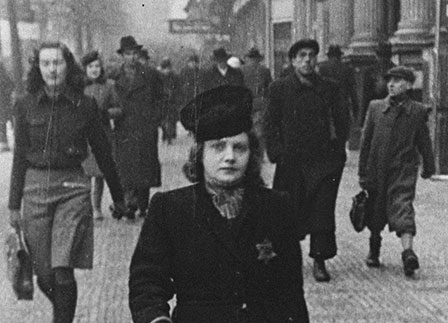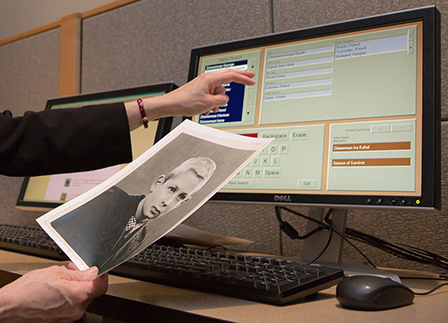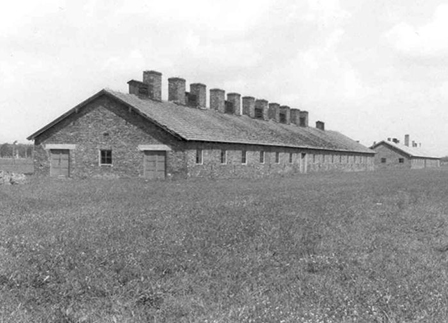Overview
- Brief Narrative
- Bound booklet, "Kwatrijnen van Omar Khayyam" [Poetry of Omar Khayyam) that was printed in secret in 1944 in German occupied Holland as a cover and fund raiser for resistance activities. It was based on the English text and the translator used the pseudonym, Ponticus. It was given to Andries Roos, who was a forger of ID and ration cards for the Dutch resistance. On May 10, 1940, Nazi Germany invaded the Netherlands where Andries lived with his wife, Rozet, 2 year old son, Leo, and brother, sister-in-law, and niece, Abraham, Rachel, and Leni Roos. In summer 1940, Andries and Rozet went into hiding and Leo and Leni, an infant, were sent to a children’s home. Leo was caught in an SS raid, but Andries, a forger for the Dutch resistance, arranged his rescue. Leo and his parents lived in hiding in Amsterdam until 1943, when they moved to Ede, then in early 1944, Heelsum. In September, they were caught between American and German troops during Operation Market Garden. The family was briefly detained by the SS, and then left for Wageningen. The Germans raided their hiding place and Andries was caught with his forging equipment. Andries, 42, was executed on November 9, 1944. Leo and Rozet were hidden on a farm in Lunteren, where they were liberated in May 1945. They returned to Amsterdam in late 1945 and learned that most of their family had been killed in the camps. Leni's parents had been killed and Rozet obtained custody of the girl from the family that rescued her. Rozet, Leo, and Leni emigrated to the United States in 1950.
- Title
- Kwatrijnen van Omar Khayyam
- Alternate Title
- Rubaiyat. Dutch
- Date
-
publication/distribution:
1944
received: 1944
- Geography
-
publication:
Utrecht (Netherlands)
- Credit Line
- United States Holocaust Memorial Museum Collection, Gift of Leo Roos
- Contributor
-
Illustrator:
John Buckland Wright
Publisher: De Bezige Bij
Translator: Henrcius Wybrandus Jacobus Maria Keuls
Author: Omar Khayyam
Subject: Andries Roos
Subject: Leo Roos
- Biography
-
Andries Roos was born on December 16, 1901, in Amsterdam, Netherlands, to Hartog and Leentje Kool Roos. Andries had eight siblings: Abraham Meijer, born January 3, 1911; Leon, Louis, Philip, Yap, Rachel, Anna, and Avalina. Andries’s father Hartog was born on July 30, 1874, and his mother Leentje was born on July 10, 1875. On December 24, 1930, Andries married Roosje (Rozet) Agsteribbe. Rozet was born on March 6, 1905, in Amsterdam, to Joseph and Kaatje de Rood Agsteribbe. Rozet had two sisters: Sophia, born December 1, 1909, and Rachel, born June 5, 1907. Rozet’s father Joseph was born on August 8, 1879, and her mother Kaatje was born on March 22, 1870. Both of their families had lived in the Netherlands for centuries. Andries’s brother Abraham married Rozet’s sister Rachel. Rozet was a seamstress and Andries sold leather goods and traveled for work. They had a son, Leo, on November 10, 1937. Andries, Rozet, and Leo moved to a town outside of Amsterdam. They lived with Andries’s brother and sister-in-law, Abraham and Rachel, who had a daughter, Helene (Leni) in 1940.
On May 10, 1940, Germany invaded Holland. After the invasion, Andries' family moved back to Amsterdam with Abraham, Rachel, and Leni. When anti-Jewish restrictions prevented Andries from traveling, he worked with his brothers in their watch store. As the persecution of Jews worsened, the family decided to go into hiding. Andries, Rozet, Abraham, and Rachel were not able to bring their young children into hiding with them because it was too risky. In summer 1940, Leo and his cousin Leni were sent to a children’s home in Heemstede, where Leo was molested. Andries and Rozet were hidden in the apartment of a resistance member in Amsterdam. Abraham and Rachel, who was pregnant, hid elsewhere. After three months, the children’s home was raided and Andries’s son Leo was brought to a collection center in Amsterdam. Leni did not look Jewish and remained in the home. Andries was active in the Dutch resistance and was a talented forger who made ID cards and ration cards. He was informed that Leo was in the collection center and arranged to have him rescued during transport to Westerbork transit camp. Members of the Underground blew up the train tracks and took children off the train. The man who was hiding Andries and Rozet took Leo to the apartment in Amsterdam and the family was reunited. Leo was very sick when he arrived, but a doctor in the resistance took care of him.
In 1943, the resistance moved Andries, Rozet, and Leo to Ede. They stayed with a poor family who took them in for money. Andries and Rozet worked for the family, making clay beads. Andries continued making false papers for the resistance. In early 1944, the resistance was warned of a raid and moved them to Heelsum, a town near Arnhem. They stayed with a pastor who treated them well. Andries and Rozet started bleaching Leo’s hair and eyebrows so that he appeared less Jewish and could play outside. On September 17, 1944, Operation Market Garden began and American paratroopers dropped into the area around Arnhem, including Heelsum. Andries and his family believed they were liberated and came out of hiding. When the German counterattack began, they were caught between the American and German troops and hid in the cellar for two weeks while the fighting continued around them. The German Army began evacuating Dutch civilians from the area and moving them toward Ede. Andries tried to take his family toward Lunteren. They were arrested by the German SS but overnight, two young German soldiers let them go. They went to Wageningen and were placed in hiding with another family. In early November, the farm was raided by Germans. Andries told Rozet and Leo to run. He stayed behind to hide his forging plates and was caught with the equipment. On November 9, 1944, 42 year old Andries was shot by a firing squad in Apeldoorn for being a member of the resistance.
Leo Roos was born on November 10, 1937, in Amsterdam, Netherlands, to a Jewish couple, Andries and Roosje (Rozet) Agsteribbe Roos. Andries was born on December 16, 1901, and Rozet was born on March 6, 1905, both in Amsterdam. Andries had eight siblings and Rozet had two. Andries and Rozet were married on December 24, 1930. Both of their families had lived in the Netherlands for centuries. Andries’s brother Abraham married Rozet’s sister Rachel. Rozet was a seamstress and Andries sold leather goods and traveled for work. Andries, Rozet, and Leo moved to a town outside of Amsterdam. They lived with Leo’s aunt and uncle, Abraham and Rachel, who had a daughter, Helene (Leni) in 1940.
On May 10, 1940, Germany invaded the Netherlands. After the invasion, Leo and his family moved back to Amsterdam with Abraham, Rachel, and Leni. When anti-Jewish restrictions prevented Andries from traveling, he worked with his brothers in their watch store. As the persecution of Jews worsened, the family decided to go into hiding. Andries, Rozet, Abraham, and Rachel were not able to bring their young children into hiding with them because it was too risky. In summer 1940, Leo and his cousin Leni were sent to a children’s home in Heemstede, where Leo was molested. After three months, the home was raided by the German SS and all circumcised boys and Jewish looking girls were taken. Leo was sent to a collection center in Amsterdam. Leni, who did not appear Jewish, was not selected and remained in the home. Andries and Rozet were given refuge in the apartment of a resistance member in Amsterdam. Abraham and Rachel, who was pregnant, were in hiding elsewhere. Andries was active in the Dutch resistance and was a talented forger who made ID cards and ration cards. He was informed that Leo was in the collection center and arranged to have him rescued during transport to Westerbork transit camp. Members of the underground blew up the train tracks and took children off the train. The man who was hiding Andries and Rozet brought Leo to the apartment in Amsterdam and the family was reunited. Leo was very sick when he arrived, but a doctor in the resistance took care of him. Leo had to sit quietly all day so the neighbors below would not hear him. They stayed there until early 1941, when a neighbor found out about them. They were then placed with the Van Grinten family in another area of Amsterdam. The Germans had deported Mr. Van Grinten to a concentration camp because he was a Communist.
In 1943, the resistance moved Andries, Rozet, and Leo to Ede. They stayed with a poor family who took them in for money. Andries and Rozet worked for the family, making clay beads. Andries continued making false papers for the underground. In early 1944, the resistance,was warned of a raid and moved them to Heelsum, near Arnhem. They stayed with a pastor who treated them well. Leo’s parents started bleaching his hair and eyebrows so that he appeared less Jewish and could play outside. On September 17, 1944, as part of Operation Market Garden, an Allied plan to liberate the region, American paratroopers were dropped into the area around Arnhem, including Heelsum. Leo and his family believed they were liberated and came out of hiding. When the German counterattack began, they were caught between US and German troops and hid in the cellar for two weeks while the fighting continued around them. The German Army began evacuating Dutch civilians from the area and moving them toward Ede. Andries tried to take his family toward Lunteren. They were arrested by the German SS, but overnight, two young German soldiers let them go. They went to Wageningen and were placed in hiding with another family. In early November, the farm was raided by German authorities. Andries told Rozet and Leo to run and stayed behind to hide his forging plates. Rozet and Leo escaped to a farm in Lunteren. After a week, Rozet was told that Andries had been caught with the forging equipment. On November 9, 1944, 42 year old Andries was shot by a firing squad in Apeldoorn for being a member of the resistance. In May 1945, Leo and Rozet were liberated in Lunteren. The war ended when Germany surrendered on May 7.
In late 1945, Leo and Rozet returned to Amsterdam. They went to the Red Cross office to view the lists of those had survived the war. Some of Leo’s paternal aunts and uncles had survived, but most of their family had been deported to Auschwitz and killed: Leo’s maternal grandparents, Joseph and Kaatje, killed on September 24, 1942; Leo’s paternal grandparents, Hartog and Leentje, killed on February 12, 1943; Leo’s maternal aunt, Sophia Klint, killed on November 19, 1943; Leo’s maternal uncle, Jakob Klint, killed on March 31, 1944; Leo’s maternal aunt Rachel and her daughter Carla (b. 1943), killed on January 28, 1944; and Leo’s parental uncle Abraham Meijer Roos, killed on January 1, 1945. They learned that Leo’s cousin, Leni, was alive and living with a Protestant family. Rozet sought and won custody for Leni and she moved in with Rozet and Leo. Leo entered school and had difficulty catching up. He had never attended school, although Andries had taught him to read. The other children made antisemitic remarks and hit him, so he was put in a Jewish school. On January 25, 1950, Rozet, Leo, and Leni left Holland, sailing from Rotterdam on the SS Veendam and arriving in New York on February 7. Rozet was unable to care for both children by herself, so she gave Leni to a relative. In 1951, Rozet married Joel Trompetter (1909-1973). Joel was a survivor from Amsterdam who had been imprisoned in Auschwitz, Mauthausen, and Ebensee concentration camps. Leo got his Bachelor of Science degree in chemistry from the City College of New York, where he met Sonya Ingrid Rosenfeld (b. 1940). Sonya’s parents had fled from Frankfurt, Germany, to London in 1940. In January 1960, Leo and Sonya married. They have three children. In 1965, Leo received his PhD in chemistry from the University of Cincinnati and worked as a research chemist. Rozet, age 98, died on July 10, 2003.
Physical Details
- Language
- Dutch
- Classification
-
Books and Published Materials
- Category
-
Books and pamphlets
- Object Type
-
Pamphlets (lcsh)
- Physical Description
- 27 p. : ill. ; 29 cm. With poetry in numbered stanzas and illustrations by John Buckland Wright on facing pages.
Imprint date from colophon 1944. Dit is no. 40. Printed on watermarked paper.
"Deze twee en veertig kwatrijnen van Omar Khayyam werden door den dichter Ponticus in de Nederlandsche taal uit de Engelsche bewerking van Edward Fitzgerald overgebracht."
Rights & Restrictions
- Conditions on Access
- No restrictions on access
- Conditions on Use
- No restrictions on use
Keywords & Subjects
Administrative Notes
- Legal Status
- Permanent Collection
- Provenance
- The booklet was donated to the United States Holocaust Memorial Museum in 2013 by Leo Roos, the son of Andries Roos.
- Funding Note
- The cataloging of this artifact has been supported by a grant from the Conference on Jewish Material Claims Against Germany.
- Record last modified:
- 2022-07-28 17:51:07
- This page:
- http://collections.ushmm.org/search/catalog/irn49152
Download & Licensing
In-Person Research
- By Appointment
- Request 21 Days in Advance of Visit
- Plan a Research Visit
- Request to See This Object
Contact Us
Also in Andries Roos family collection
The collection consists of an armband, a tallit and pouch, and a book relating to the experiences of Andries Roos, and his son Leo Roos, before and during the Holocaust in Amsterdam, Netherlands, during which Andries was executed for his resistance activity and Leo and other family members lived in hiding.
Date: 1936-1950
Tallit and storage pouch buried and recovered by a Dutch Jewish family
Object
Striped tallit and storage bag recovered by Leo Roos after the war. The tallit was a family heirloom that had belonged to Abraham Agsteribbe, Leo’s maternal great grandfather, who died in 1911. The tallit, a prayer shawl worn by observant Jewish men during morning services, had been buried by a relative underneath the Portuguese Synagogue in Amsterdam in 1940, before the outbreak of war. On May 10, 1940, Nazi Germany invaded the Netherlands where Andries lived with his wife, Rozet, 2 year old son, Leo, and brother, sister-in-law, and niece, Abraham, Rachel, and Leni Roos. In summer 1940, Andries and Rozet went into hiding and Leo and Leni, an infant, were sent to a children’s home. Leo was caught in an SS raid, but Andries, a forger for the Dutch resistance, arranged his rescue. Leo and his parents lived in hiding in Amsterdam until 1943, when they moved to Ede, then in early 1944, Heelsum. In September, they were caught between American and German troops during Operation Market Garden. The family was briefly detained by the SS, and then left for Wageningen. The Germans raided their hiding place and Andries was caught with his forging equipment. Andries, 42, was executed on November 9, 1944. Leo and Rozet were hidden on a farm in Lunteren, where they were liberated in May 1945. They returned to Amsterdam in late 1945 and learned that most of their family had been killed in the camps. Leni's parents had been killed and Rozet obtained custody of the girl from the family that rescued her. Rozet, Leo, and Leni emigrated to the United States in 1950.
Air Raid Service warden armband used prewar by Dutch Jewish resistance member
Object
Luchtbeschermingsdienst [Air Raid Warden] armband used by Andries Roos circa 1936 to May 1940, when the German occupation authorities released Jews from serving in the Luchtbeschermingsdienst (Air Raid Defense Service). The Service was established in 1936 to protect the city against air attacks and to organize emergency services. On May 10, 1940, Nazi Germany invaded the Netherlands where Andries lived with his wife, Rozet, 2 year old son, Leo, and brother, sister-in-law, and niece, Abraham, Rachel, and Leni Roos. In summer 1940, Andries and Rozet went into hiding and Leo and Leni, an infant, were sent to a children’s home. Leo was caught in an SS raid, but Andries, a forger for the Dutch resistance, arranged his rescue. Leo and his parents lived in hiding in Amsterdam until 1943, when they moved to Ede, then in early 1944, Heelsum. In September, they were caught between American and German troops during Operation Market Garden. The family was briefly detained by the SS, and then left for Wageningen. The Germans raided their hiding place and Andries was caught with his forging equipment. Andries, 42, was executed on November 9, 1944. Leo and Rozet were hidden on a farm in Lunteren, where they were liberated in May 1945. They returned to Amsterdam in late 1945 and learned that most of their family had been killed in the camps. Leni's parents had been killed and Rozet obtained custody of the girl from the family that rescued her. Rozet, Leo, and Leni emigrated to the United States in 1950.



